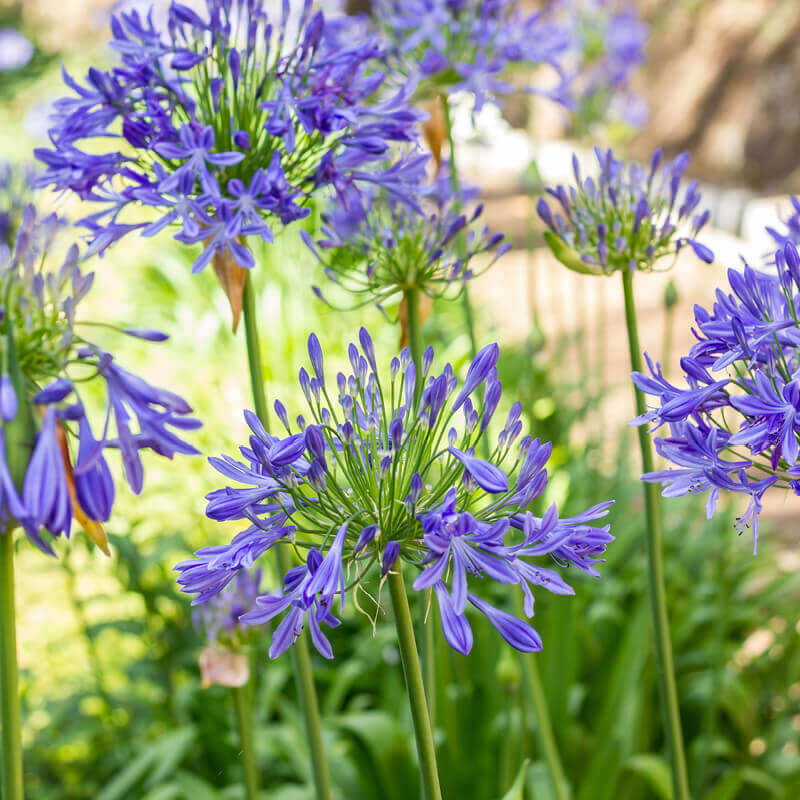Seasonal Agapanthus Care: Getting Ready For Winter and Summertime
Letting Loose the Secret to Effective Agapanthus Cultivation: Tips and Tricks for a Flourishing Garden
In the realm of horticulture, cultivating agapanthus effectively needs a calculated approach that includes various aspects of plant care. By understanding the subtleties of agapanthus farming, one can produce an environment where these plants thrive and grow generously.
Growing Agapanthus: Ideal Practices
When planting Agapanthus, correct dirt prep work is necessary for ensuring successful development and growth of these attractive blossoms. Agapanthus, frequently referred to as Lily of the Nile or African lily, flourishes in well-draining soil with a slightly acidic to neutral pH degree - Agapanthus. Prior to growing, it is essential to modify heavy clay dirts with organic issue such as garden compost or peat moss to enhance water drainage and supply important nutrients for the plants
To grow Agapanthus, choose a place that obtains full sunshine to partial shade, as this will promote healthy and balanced growth and bountiful flowering. Dig a hole twice the diameter of the plant's root ball and put the Agapanthus at the very same depth it was formerly expanding. Gently backfill the hole with dirt, pushing down securely to remove any type of air pockets around the origins.
Water the newly planted Agapanthus extensively and remain to keep the soil evenly moist, particularly throughout the plant's energetic growing season. Agapanthus. Using a well balanced plant food once a month can further support the plant's development and blooming. By following these best methods for growing Agapanthus, you can create a sensational display screen of these captivating flowers in your garden
Suitable Dirt Issues for Agapanthus
For optimal development and blooming success of Agapanthus plants, ensuring the dirt conditions are optimal is important. Agapanthus chooses soil that is abundant in nutrients, so including a balanced plant food during the growing period can promote healthy development and vibrant flowers.

Watering and Feeding Tips
To make certain healthy and balanced development and vibrant blooms, proper watering and feeding methods are crucial for effective Agapanthus cultivation. Agapanthus plants benefit from regular watering, especially during the growing season. It is recommended to water deeply when a week, making certain the dirt is wet yet not saturated. Throughout warm weather condition or in pots, even more regular watering may be required to stop the soil from drying out completely.
When it involves feeding Agapanthus, a balanced fertilizer with equivalent components nitrogen, phosphorus, and potassium can be applied in the spring to advertise healthy and balanced growth and flowering. Slow-release plant foods are optimal for giving nutrients progressively over a prolonged period. Stay clear of over-fertilizing, as this can cause extreme foliage development at why not try these out the cost of blooms.
In addition, integrating organic issue like compost into the dirt can improve nutrient levels and boost soil structure, aiding in the overall wellness of the Agapanthus plants. By complying with these watering and feeding ideas, gardeners can guarantee their Agapanthus plants flourish and generate spectacular displays of blossoms.
Pruning and Deadheading Strategies
Proper trimming and deadheading strategies play an essential role in keeping the health and wellness and appearances of Agapanthus plants, enhancing the crucial techniques of watering and fertilizing for effective cultivation. Trimming Agapanthus includes getting rid of invested flower heads, yellowing or dead fallen leaves, and general shaping of the plant to advertise much better development. Deadheading, the process of getting rid of discolored flowers, not only boosts the plant's appearance however additionally encourages additional growing.
When deadheading Agapanthus, it is suggested to clip off the blossom stem at the base using sharp, clean shears. This procedure reroutes the plant's energy from seed manufacturing back into origin and vegetation growth, promoting a healthier and much more robust plant. Routine deadheading can prolong the blooming period of Agapanthus and stop self-seeding, which can bring about overcrowding.
In regards to trimming, Agapanthus usually gain from a light trim after blooming to clean up the plant and encourage fresh growth. Cutting down the spent blossom stems and removing any dead or damaged vegetation aids keep the plant's vigor and general appearance. Nevertheless, it is important to prevent reducing into the crown of the plant, as this can compromise its health.

Protecting Agapanthus From Vermins and Diseases
Carrying out effective pest and condition management approaches is important to safeguarding the health and wellness and vigor of Agapanthus plants in growing. One usual insect that influences Agapanthus is the Agapanthus click here now borer, a caterpillar that tunnels right into the plant, causing damage to the flowers and fallen leaves.
In addition to insects, Agapanthus are vulnerable to illness such as root rot and fungal leaf spots. By staying vigilant and addressing pest and disease concerns promptly, gardeners can aid their Agapanthus grow and prosper.

Verdict
In final thought, effective cultivation of agapanthus needs proper growing techniques, excellent soil problems, appropriate watering and feeding, regular trimming and deadheading, and defense from pests and illness. By following these ideas and methods, garden enthusiasts can ensure a growing yard filled with lovely agapanthus blossoms. Agapanthus. Remember to maintain constant treatment and focus to information to promote the wellness and longevity of these spectacular plants
When planting Agapanthus, appropriate dirt prep work is important for making sure effective development and development of these gorgeous flowers.Water the recently grown Agapanthus thoroughly and continue to keep the soil click over here evenly moist, especially during the plant's energetic expanding period.For ideal development and flowering success of Agapanthus plants, making sure the dirt problems are suitable is vital. When transplanting or planting Agapanthus, ensure the soil is well-prepared to provide the necessary structure for the plants to develop themselves successfully. One typical insect that impacts Agapanthus is the Agapanthus borer, a caterpillar that passages into the plant, triggering damage to the leaves and flowers.